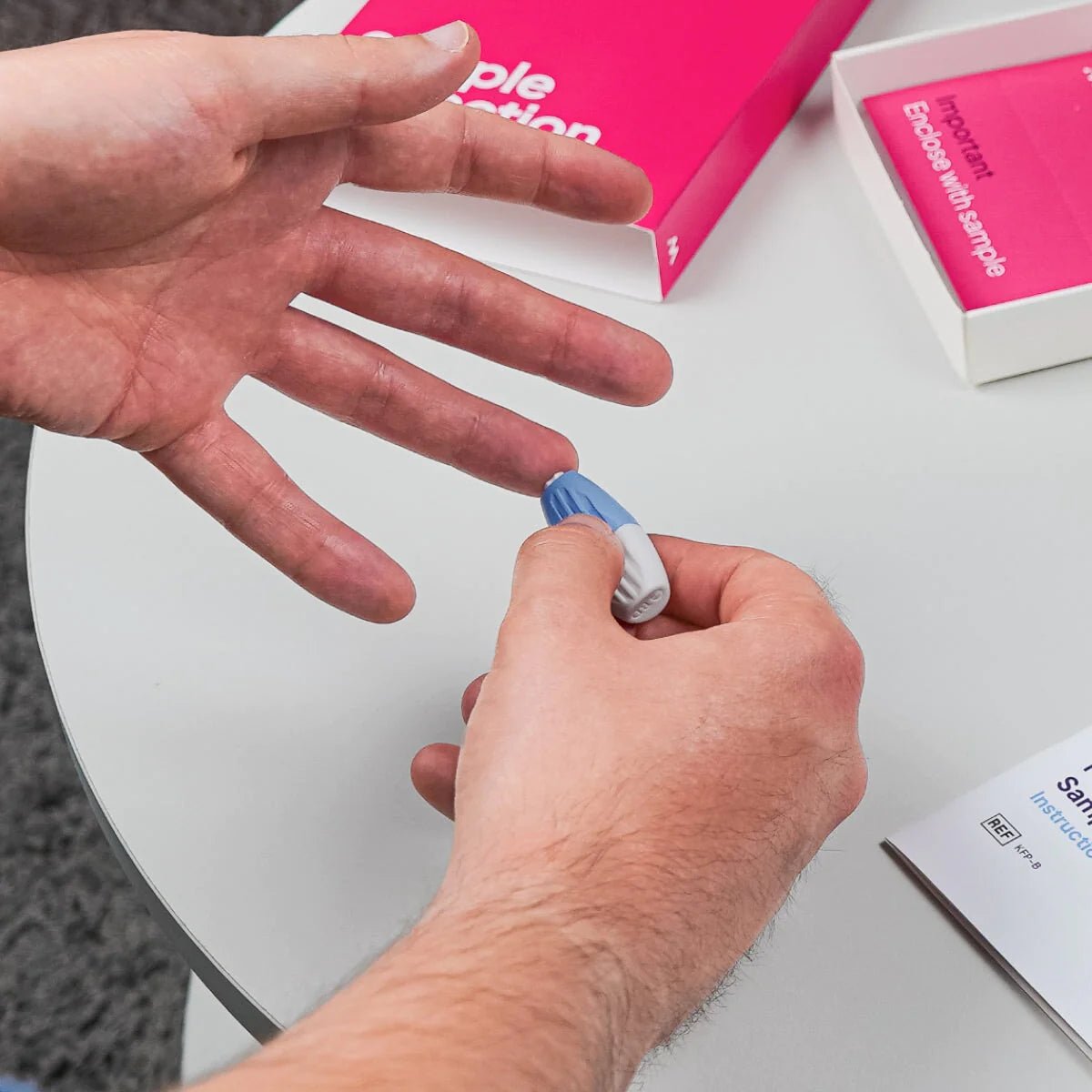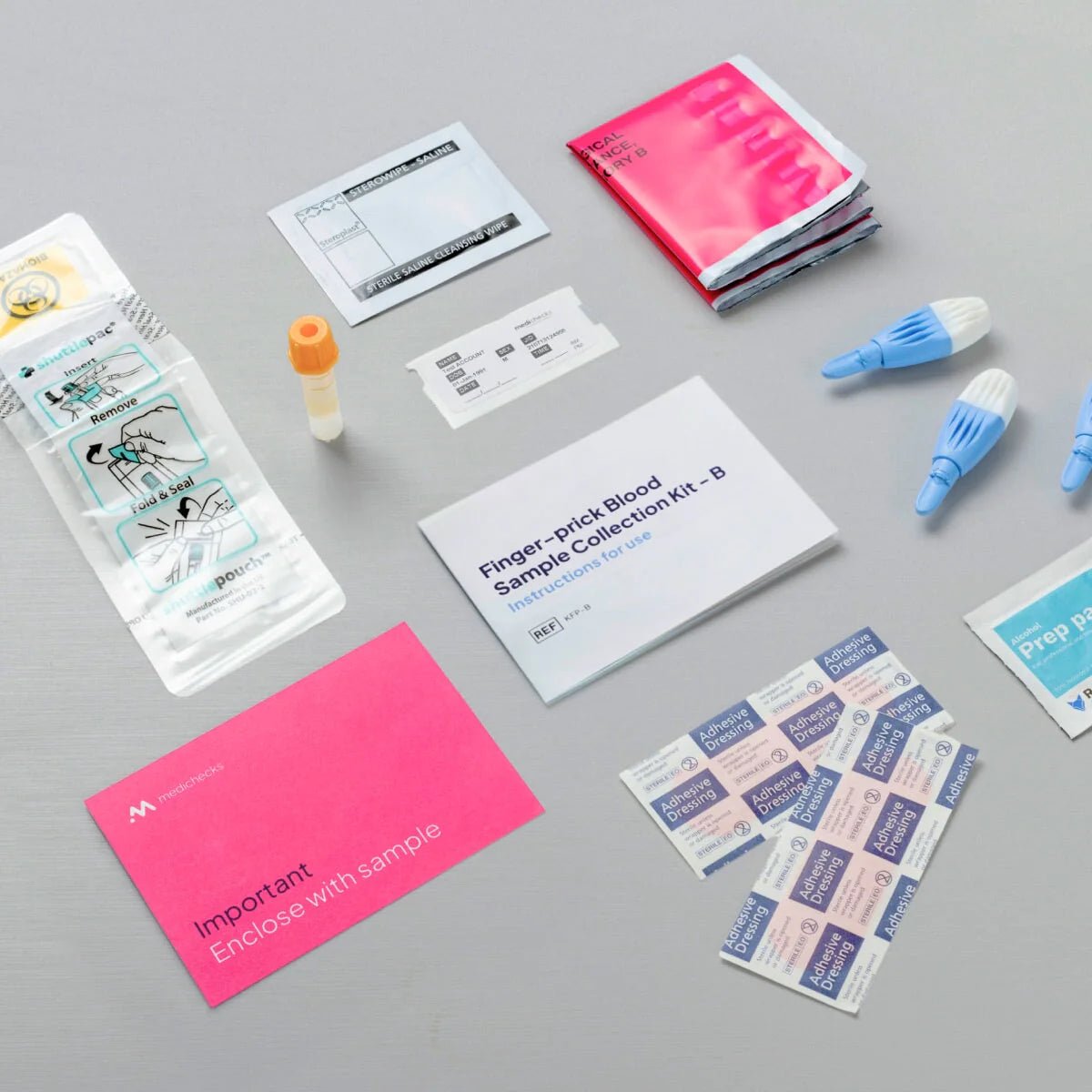Apolipoprotein Profile Blood Test
Description
This home blood test measures your levels of apolipoprotein B and A1 to help assess your risk of cardiovascular disease, such as heart attacks and strokes. It also includes cholesterol and triglyceride levels, as well as your apoB:apoA1 ratio, which gives a good indication of the balance of good and bad cholesterol in your blood. Your results can give you additional insights into your risk of heart disease and may help you take positive steps to reduce your bad cholesterol levels and improve your cardiovascular health.
Is it for me?
Are you looking for deeper insights into your heart disease risk? Perhaps you want to make lifestyle changes to reduce your levels of bad cholesterol and improve your cardiovascular health.
Our apolipoprotein b blood test is thought to give a more accurate reflection of your heart disease risk than a standard cholesterol test. And your results can help you take action and reduce your levels of bad cholesterol.
Apolipoprotein Profile Blood Test, from our experts to you.
What are apolipoproteins?
Apolipoproteins are proteins that help carry fats, such as cholesterol and triglycerides, around your body for use in your tissues and cells.
There are various forms of apolipoproteins, and they play a vital role in balancing the levels of good and bad cholesterol in your body. Apolipoprotein A1 (or apoA1) forms part of good (HDL) cholesterol and helps remove excess cholesterol from your body. In contrast, apolipoprotein B (or apoB) combines with fats to form bad (non-HDL) cholesterol and encourages this to be taken up by your cells.
Too much bad cholesterol can cause fatty deposits (plaques) to form in your arteries. This process is known as atherosclerosis, a condition where the arteries narrow, reducing blood flow, and increasing your risk of heart disease or stroke.
What can I learn from an apolipoprotein b blood test?
By measuring the levels of apolipoproteins in your blood, our test can give you a clearer picture of your risk of cardiovascular (heart and blood vessel) disease.
Traditionally, bad cholesterol levels have been used to assess heart disease risk. However, standard cholesterol tests may miss the build-up of small, dense particles of bad cholesterol in your blood. And as these particles are thought to significantly add to your heart disease risk, conventional cholesterol tests could underestimate your risk.
As each bad cholesterol particle, regardless of size or density, carries one apoB molecule, an apoB check can better reflect the number of potentially damaging particles in your blood. Coupling your apoB level with your protective apoA1 level in a ratio can also help determine your risk of heart disease.
Our test also checks standard markers for heart disease risk, including your levels of bad cholesterol. And if your apoB level is high, you will usually have similarly high levels of bad cholesterol. However, research has shown that if cholesterol and apoB results don’t agree with each other, apolipoprotein b blood test is the more accurate of the two at estimating your heart disease risk.
What causes a high apoB blood test result?
There are many reasons why your apoB level might be raised. These include lifestyle factors, such as a high-fat diet, being overweight, and a leading a sedentary lifestyle.
High levels of apoB can also be caused by underlying health conditions such as diabetes, an underactive thyroid (hypothyroidism), and chronic kidney disease (CKD).
Other reasons include being pregnant, which can temporarily cause a high apoB level, and some genetic disorders. The use of drugs like beta blockers and diuretics can also affect your apoB level.
What's Included?
Cholesterol status
Total Cholesterol
Cholesterol is an essential fat (lipid) in the body. Although it has a bad reputation it has some important functions, including building cell membranes and producing a number of essential hormones including testosterone and oestradiol. Cholesterol is manufactured in the liver and also comes from the food we eat. Although there are a number of different types of cholesterol, the two main components of total cholesterol are HDL (high density lipoprotein) which is protective against heart disease and LDL (low density lipoprotein) which, in high levels, can contribute to cardiovascular disease. Your total cholesterol result on its own is of limited value in understanding your risk of heart disease; high levels of HDL cholesterol can cause a raised total cholesterol result but may actually be protective against heart disease. Equally, you can have a normal total cholesterol level but have low levels of protective HDL cholesterol. The most important factors are how much HDL and LDL cholesterol you have, and what proportion of your total cholesterol is made up of protective HDL cholesterol. We give a detailed breakdown of the components of your total cholesterol in the rest of this cholesterol profile.
LDL Cholesterol
LDL cholesterol (low-density lipoprotein) is a molecule made of lipids and proteins which transports cholesterol, triglycerides and other fats to various tissues throughout the body. Too much LDL cholesterol, commonly called 'bad cholesterol', can cause fatty deposits to accumulate inside artery walls, potentially leading to atherosclerosis and heart disease.
Non - HDL Cholesterol
Your total cholesterol is broken down into 2 main components; HDL (good) cholesterol and LDL (bad). There are more types of harmful cholesterol in your blood than just LDL - these include VLDL (very low-density lipoproteins) and other lipoproteins which are thought to be even more harmful than LDL cholesterol. Non-HDL cholesterol is calculated by subtracting your HDL cholesterol value from your total cholesterol. It therefore includes all the non-protective and potentially harmful cholesterol in your blood, not just LDL. As such, it is considered to be a better marker for cardiovascular risk than total cholesterol and LDL cholesterol. The recommended level of non-HDL cholesterol is below 4 mmol/L.
HDL Cholesterol
HDL cholesterol (high-density lipoprotein) is a molecule in the body which removes cholesterol from the bloodstream and transports it to the liver where it is broken down and removed from the body in bile. HDL cholesterol is commonly known as 'good cholesterol'.
Total Cholesterol : HDL
The cholesterol/HDL ratio is calculated by dividing your total cholesterol value by your HDL cholesterol level. It is used as a measure of cardiovascular risk because it gives a good insight into the proportion of your total cholesterol which is good (i.e. high-density lipoprotein HDL). Heart disease risk tools (such as QRisk) use the cholesterol/HDL ratio to calculate your risk of having a heart attack.
Triglycerides
Triglycerides are a type of fat (lipid) that circulate in the blood. After you eat, your body converts excess calories (whether from fat or carbohydrates) into triglycerides which are then transported to cells to be stored as fat. Your body then releases triglycerides when required for energy.
Apolipoprotein A1
Apolipoprotein A1, or ApoA1, is the main protein found in high-density lipoprotein (HDL) cholesterol. The higher your Apo1 result, the more HDL cholesterol particles you have. HDL cholesterol helps clear cholesterol from the blood by removing cholesterol from organs and tissues to be broken down by the liver.
A low ApoA1 level, especially with a raised ApoB result, is associated with an increased risk of cardiovascular disease. ApoA1, alongside other risk factors, can help to build a picture of your overall cardiovascular risk and likelihood of heart attack and stroke in later years.
Apolipoprotein B
Apolipoprotein B, or ApoB, is the main protein found in lipoproteins such as low-density lipoprotein (LDL) cholesterol and ultra-low-density lipoproteins (chylomicrons). Each of these lipoproteins contains one ApoB particle. So, your ApoB levels can tell you the number of these lipoproteins in the blood, which is why ApoB is considered a better predictor of heart disease risk than LDL cholesterol measurements.
ApoB plays a crucial role in transporting lipids (fats) around the body, but too much ApoB is linked to conditions like atherosclerosis, heart attacks, and strokes, which can affect your lifespan and your quality of life in later years.
Apo B : Apo A Ratio
Your ApoB:ApoA1 ratio is calculated by dividing your ApoB level by your ApoA1 level. It’s considered a better predictor of cardiovascular risk than your individual apolipoprotein results alone, or other cholesterol ratios such as an LDL:HDL ratio.
A higher ratio is linked to an increased risk of heart attacks, vascular disease, and stroke, all of which can impact not just how long you live, but how many years you spend in good health.
How to prepare for your test
Prepare for your Apolipoprotein B Blood Test by following these instructions. Do not eat or drink anything other than water for 12 hours prior to your test. If you take medication then you are allowed to take it as you would normally.
FAQ
What Is A Normal ApoB Blood Test Result?
The normal range for apoB varies depending on the ranges used by the lab processing your results, but generally, it’s <1 g/L for apolipoprotein B.
What Happens If My ApoB Test Result Is High?
Having a high apoB level doesn’t cause any obvious symptoms. Most people with high apoB levels don’t find out they have it until they develop a serious health condition, such as a heart attack or stroke.
As you can have a high apoB level without knowing, you may wish to monitor your level or repeat your apolipoprotein b blood test following lifestyle changes. Alternatively, your doctor may advise monitoring your cholesterol levels.
What Can I Do To Lower My ApoB Level?
Making changes to your lifestyle such as taking regular exercise and following a heart-healthy diet, such as the Mediterranean diet, can help to lower your apoB level. And this can help decrease your risk of heart disease.
Controlling any underlying medical conditions that could contribute to a raised apoB level, such as diabetes and hypothyroidism, can also help to get your level into the normal range.
In some cases, you may be prescribed medication. Your GP will be able to offer advice and guidance if your apoB level is outside the normal range.
What Does A Low ApoB Test Result Mean?
A low apoB test result could be due to an underlying health condition such as an overactive thyroid (hyperthyroidism) or advanced liver disease. Malnutrition, severe illness, or medications (like thyroxine or statins) can also contribute to lower levels of apoB. Very rarely, genetic conditions, such as apolipoprotein B deficiency or Bassen-Kornzweig syndrome, may cause abnormally low levels of apoB.
What Can I Learn From My ApoB:ApoA1 Ratio?
The apoB:apoA1 ratio gives a good indication of the balance of good and bad cholesterol in your blood. It measures how much unhealthy apoB is in your blood and divides this by your protective apoA1 level. A low number (typically, below 1) is considered optimal, with a higher result suggesting an increase in your risk of cardiovascular disease.
Can I Take An ApoB Test At Home?
Yes, you can take an apoB test at home with our finger-prick blood test kit. We’ll send you everything you need, including clear instructions and a pre-paid return envelope for your sample.
How Can I Test My ApoB Level At Home?
Our apoB home test includes a full lab analysis of your blood sample and a doctor’s advice to help you take action to improve your health and wellbeing. You can access your results on your MyMedichecks dashboard, alongside a doctor’s comments and any next steps.
BE MORE JELLYFISH
The science of Longevity is growing at breakneck speed and tens of BILLIONS of dollars are being invested in solutions to help us all slow aging. But until 'Longevity Escape Velocity' has been achieved, we should all be more like Turritopsis Dohrnii jellyfish - which do not age - and we should invest in our long-term health with a healthy lifestyle, supported by longevity supplements.
Worldwide
Guarantee
Payment
Policy







